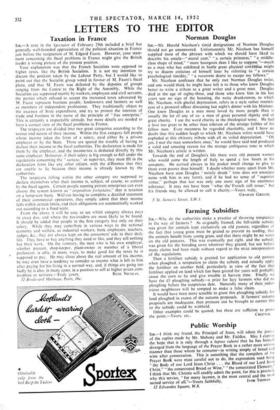Farming Subsidies
S1R,—Why do the authorities make a practice of throwing temptation in the way of farmers ? As originally framed, the hill-cattle subsidy was given for animals kept exclusively on old pasture, regardless of the fact that young grass must be grazed to prevent its seeding, that the animals benefit from young grass, and that there might be no water On the old pastures. This was eventually put right, and the subsidy was given for the breeding cows wherever' they grazed, but not before many claims had been made without regard to the strict interpretation of the regulations.
Then a fertiliser subsidy is granted for application to old pasture when ploughed, a temptation to claim the subsidy and actually apply the fertiliser on another field, particularly in view of the fact that fertiliser applied on land which has been grazed for years will probably cause the corn to lie and give trouble at harvest time. Finally we have the 0 ploughing subsidy—a prize for lazy farmers who did no .ploughing before the auspicious date. Naturally many of their indus- trious neighbours will be tempted to make a false claim. It would have been more sensible to grant this ploughing subsidy for land ploughed in excess of the autumn proposals. If farmers' autumn proposals are inadequate, then pressure can be brought to correct this or the subsidy could be withheld. Other examples could be quoted, but these are sufficient to prove










































 Previous page
Previous page